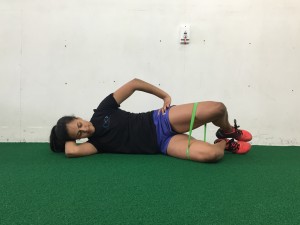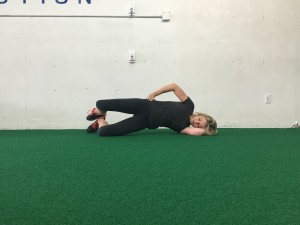You can read about why having a strong glutes is important here and here, but this post is all about the glute maximus’ little brother, the glute medius. The gluteus medius muscle is an important, yet often overlooked muscle in many training programs.
Strong glute meds are essential for lateral hip stability. They also play a major role in lower extremity and lower back injury prevention and rehab. The trouble is they’re often weak and can be a tricky muscle to engage…
So where do you start? Enter the clamshell.
If you’ve done them before, you know they’re not the most exciting exercise out there… and I get it. BUT, if you perform them correctly, they should hit your glute medius’ hard. In other words, you should feel a solid burn on the side of your glute and NOT be feeling like you’re working a ton in your TFL muscle (tensor fasciae latae, see below), which sits forward of the glute med and will often dominate this movement.
This is a super easy exercise to do in front of the TV, but doing them right takes a little more concentration.
The video below gives you some helpful tips to ensure that you’re getting the most out of your Clamshells.
Once you have mastered the Clamshell and are able to create maxium tension through your glute medius, progress by throwing a miniband around your legs. Make sure that you cab still isolate where you’re feeling the exercise. If it’s not in the glute med (where I’m pointing to in the picture above) then another muscle is likely compensating.
To progress again and challenge your obliques and glute meds simultaneously, try the Low Side Plank with Clamshell demo’d below.
These exercise variations don’t always work well for everyone. So you may see better glute med activation with the Side Lying Hip Abduction exercise or a Lateral Band Walk.
There is no blanket approach to correcting muscle imbalance because no one person’s body is the same and we all have specific areas that we need to focus on. To find out how to address your specific imbalances, schedule an assessment with us!
Happy training!
Jen
References:
Distefano, L., Blackburn, J., Marshall, S., Padua, D. (2009). Gluteal Muscle Activation During Common Therapeutic Exercises. Journal of Orthopaedic & Sports Physical Therapy. 39 (7): 532-540.
Heiderscheit, Bryan (2010). Lower Extremity Injuries: Is It Just About The Hip Strength? Journal of Orthopedic Sports Physical Therapy. 40 (2): 39-41
Niemuth, Paul (2007). The Role Of Hip Muscle Weakness In Lower Extremity Injuries. International SportMed Journal. 8 (4): 179.









